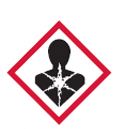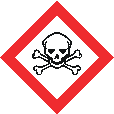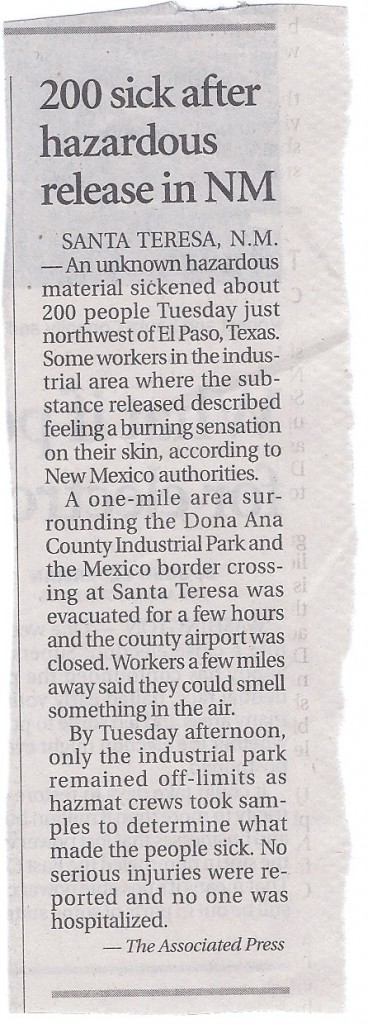Entries tagged with “industrial hygienist”.
Did you find what you wanted?
Mon 3 Dec 2012
Posted by admin under ACGIH, Federal OSHA, GHS, industrial hygienist, Management, Misc, MSDS, OSHA, PEL (Perm Exp Limit), Risk, SDS
Comments Off on Why I’m excited about the new GHS rules
The new global harmonization system (GHS) is officially adopted by OSHA. Each state run program is rolling out their acceptance of the new changes. Where I live, we have until December 2013 to train employees in this new type of hazard communication.
Honestly, I’m NOT too EXCITED about it. But, I’m trying to have a good attitude. Below are some good things which may occur:
- Raise the level of awareness of hazardous materials & their toxicity
- Train employees (hopefully, retrain) on how to handle chemicals
- More training = less citations. (?)Â OSHA’s top ten citations include #3 – hazard communication. Maybe people will actually do the training?! (my guess is that there will be more citations)
- Consistent information worldwide. Â All UN countries should have the same format. (this might take years)
- Proprietary information will be more visible on the SDS. In the new rules, manufacturers are required to list the % of their proprietary ingredients.
- Pictograms! They’re so cool. My favorite is the exploding person.
- Maybe this is my favorite?!: Manufacturers will have to look again at their products and classify them according to the physical & health criteria. Nowadays with more relevant information from worldwide occupational exposure limits, it might help make employers aware of the hazards.
- This might help OSHA enforce newer exposure limits (other than the 1978 AGCIH TLVs).

How do you plan on training your employees? If you need help, contact me here.
Wed 7 Nov 2012
The answer is Yes.
If you are working with lead (in any amount) and you are performing any of the “trigger tasks” in construction = you must follow OSHA rules. Trigger tasks are demolition, removal, encapsulation, new construction, installation, cleanup, abrasive blasting, welding, cutting, torch burning, transporting, storing, heat gun work, sanding, scraping, spray painting, burning, welding, etc. What about the EPA rules (RRP)? Look here.
The only exceptions to not measuring employees blood lead are:
- On the first day of work activity, you perform air sampling (for the full shift) and can prove the airborne levels are below the Action Limits (<30 ug/m3)…or,
- OR…If you have relevant historical data and can prove your airborne levels during the same tasks are below the Action Limit (within the last 12 months). Relevant historical data must be REALLY relevant. Like, same work activity, same amount of lead in the paint, same general size/location, etc, etc.
These are the only exceptions.
If you choose to NOT perform blood lead monitoring the downsides are:
- employees might already have dangerous levels of lead in their system, and you expose them to more
- measuring blood lead levels after the exposure may indicate higher baseline blood lead levels -and you might have to pay for exposure which wasn’t your fault
- if overexposed, and they have high blood levels – you might have to also check their family’s blood lead levels
More information on blood lead testing from my earlier post.
Mon 5 Nov 2012
Posted by admin under Admin Controls, Bio Exposure Index, Biological Monitoring, Chemical Exposure, Engineering Controls, GHS, Hazard Communication, industrial hygienist, Personal Protective Equip (PPE), Respirators, Safety Programs, Training
Comments Off on Choosing hazardous products/ chemicals
When clients ask me to assist in choosing a product, I try to recommend a product with the least dangerous chemicals in it. I understand this isn’t always possible. However, I try to emphasize the worst case health scenarios and leave it up to the company to decide how to proceed. There are reasons to use a hazardous (to your health) product.
However, here are some considerations when choosing a hazardous product:
- more hazard vs less cost
- more hazard vs less time actually using product
- more hazard vs cost of PPE
- more hazard vs what the spec says
- more hazard vs different hazard
- more hazard vs terrible health effect/potential
- more hazard vs perception by others on the project (by the GC/public/subcontractors, media, neighbors)
Another issue with chemicals is the names and nomenclature. There are so many different names, common names, chemical names, and sub names of products – it gets confusing.
One solution called, ChemHat.org, offers a unique way of considering other chemicals. Plug in the CAS# (Chemical Abstract Number) or the name, and it gives you some ideas.
Another alternative in choosing the best product is to ask.
- Ask your industrial hygienist if this product is safe and/or are there concerns?
- Ask the GC if this is the only product that can be used
- Ask the architect if there are alternatives that are equally effective
- Ask the manufacturer if they have comparable products without the XXX hazard
Thu 1 Nov 2012
Posted by admin under AIHA, Air Monitoring, industrial hygienist, Presentation, Uncategorized
Comments Off on What industrial hygienists do

I’ll admit it. My elevator pitch is not the best. I have a hard time trying to briefly describe what I do as an industrial hygienist. I usually answer the question with a recent example of a interesting project.
What would you hire an industrial hygienist for? Well, this article describes exactly when you would hire one. I bet the haz mat crew has at least one hygienist investigating this concern.
AIHA has published video on what IHs do and our job function (s). They did a much better job than I could have done, but, the video is NOT as exciting as real-life.



